Verbena is a genus containing about 250 species, many of which also simply go by “verbena” in common parlance, or if we’re lucky, something like the highly specific “purple verbena.”
When I saw that my colleague here at Gardener’s Path had written a guide to growing verbena, one of my favorite ground covers, I eagerly clicked over to his article. And a fine article it is.
However, Matt’s idea of this plant, unsurprisingly, is very different from mine.
While Matt is more familiar with the varieties of this plant that do well in Pennsylvania, where he lives, what I know as verbena in central Texas seems like a completely different plant.
All that is to say: I’m here to tell you about the varieties that do well in the south and southwest US, not the ones that need tons of water and lots of babying, and I’ll explain how to care for them down here.
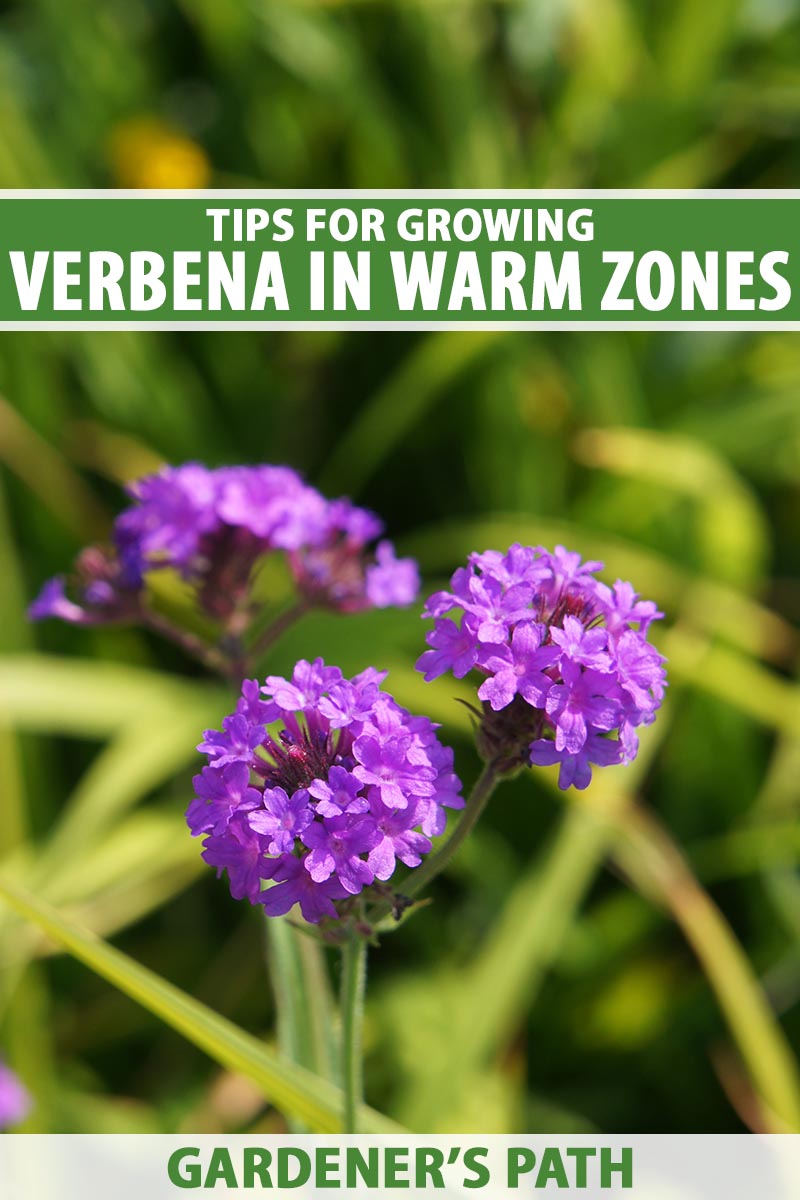
We link to vendors to help you find relevant products. If you buy from one of our links, we may earn a commission.
Let’s start with the fact that up in PA, this plant is considered an annual. But down here, our verbenas totally tough it out through our brutal, maybe-one-freeze-a-season winters.
Here’s everything I’ll cover:
What You’ll Learn
Let’s get started!
Propagation
There are several different ways that you can propagate your plants down south, whether you prefer to start seeds, take cuttings from existing plants, or transplant potted ones that you picked up from a nursery.
From Seed
Inside, you’ll want to start seeds 10 to 12 weeks before the last frost. Germination can be slow, taking as long as 28 days. Some gardeners have the best luck germinating verbena seeds in total darkness.
Fill your seed flats or individual containers with potting soil, and water so that the soil is moist but not waterlogged. Sow seeds 1/8 of an inch deep and place the container or tray in a location that maintains a temperature of 65 to 75°F. Keep the soil evenly moist until germination.
When the seeds have germinated, move the container to a sunny windowsill where they will receive bright, indirect sunlight. Alternatively, you can use a grow light.
Once the seedlings have at least two sets of true leaves, you can transplant them into individual three- to four-inch pots.
After all risk of frost has passed, you can start to acclimate your young plants by placing them outdoors in a protected location for an hour on the first day, gradually increasing the time over the course of a week to 10 days.
Transplant into the garden as discussed below.
Outside, after the danger of frost has passed (yes, it happens down here once in a while), plant seeds a quarter-inch deep, spaced 12 inches apart. Water them in well.
From Cuttings
In a small container of potting mix, insert and remove a pencil to create a hole. Take a three- to four-inch-long stem cutting just above a node.
Remove the lower leaves and dip the cut end in rooting hormone powder, and then insert the cutting into the dirt.
Place the container in a location that receives bright, indirect light, and maintain even moisture in the soil.
You can also root your snipped bits in a small glass of water.
After four to six weeks, roots should start to form. You can check for root development by gently tugging on the cutting – if you feel resistance, that’s a sign of root growth. Cuttings rooted in water may be transplanted when the roots are about an inch long.
Transplant your cuttings into a larger pot, or out into the garden as described below.
Transplanting
You can transplant seedlings or nursery starts after the danger of frost has passed.
Dig a hole about the size of the container in which the plant is currently growing.
Although they are not too fussy about soil, you may amend with a little compost to give the transplants a boost of nutrients to help them become established.
Remove the plant from its container and set it in the hole. Backfill with soil as needed and water well. Allow 12 inches of space between plants to provide adequate airflow.
How to Grow
Like Matt’s plant, mine also needs lots of sun and well-drained soil. Unlike Matt’s, however, mine doesn’t need a lot of water. Matt writes that his needs “about an inch of rain a week.”
Can I just say, the thought of this has me rolling on the floor laughing?
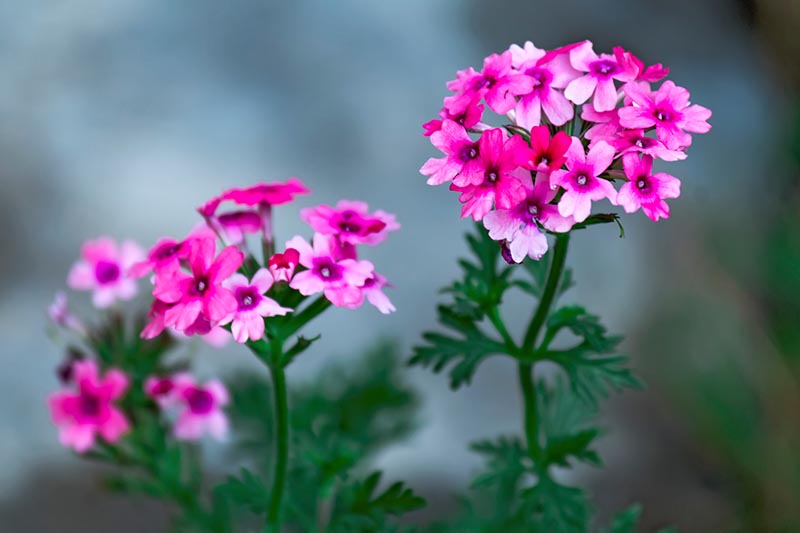
The verbena that grows wild along the hiking trail at the park across the street from my house would be lucky to get an inch of rain a month in the summertime.
It’s quite possible it would grow more vigorously and bloom more profusely with additional water, but here in Texas, we’re often looking for plants that can merely survive our summers without us having to give our entire paychecks to City of Austin Utilities for water.
However, young plants that are becoming established will benefit from regular watering, particularly during hot, dry spells. Once established, they are drought tolerant.
I can also pretty much guarantee that the soil across the street has not been amended, fertilized, or anything else highfalutin like that.
It’s just good ol’ Central Texas dirt. However, you are certainly welcome to apply a slow release, complete fertilizer such as 19-5-9 (NPK) at a rate of one pound per 100 square feet, in the spring if you like.
Growing Tips
- Grow in a full sun location.
- Provide well draining soil.
- Water during dry spells.
Pruning and Maintenance
Another commonality between the northern and southern versions of this plant is its appreciation for regular trims.
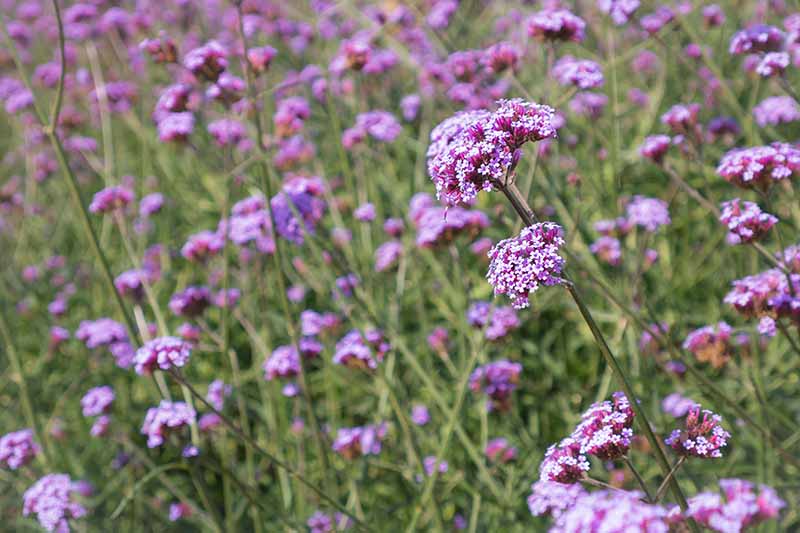
After a big flush of blooms finishes, pull out the clippers and trim back about one-quarter of the plant’s top growth, including the old flowers.
Regular trimmings will ensure prolific, repeated blooms.
If you have a big swath of verbena-covered ground, just use a line trimmer and whack away.
Species and Cultivars to Select
V. canadensis, with its rosy flowers, is native across a swath of the southeast from Virginia to Florida, and ranges as far west as Colorado and south to Mexico.
One of the more popular varieties in my region is V. canadensis ‘Homestead Purple.’ It spreads to three feet and can reach about a foot tall.
This cultivar was discovered on an old Georgia homestead, and does well in much of the South.
Find plants in three-inch pots available at Home Depot.
Of course, we residents of the Lone Star State also have a cultivar named just for us, because Texas-centered narcissism is ingrained from birth. Sporting masses of red blooms, V. x hybrida ‘Texas Rose’ was discovered in a ditch west of San Antonio.
Southeasterners might like V. bonariensis, aka purpletop vervain, which is native to South America, but naturalized in the southeastern United States.
It can grow to three feet tall and displays pretty purple flowers. Find packets of 200 seeds available from Burpee.
Those of you in the desert southwest might consider V. peruviana, a hardy species that does particularly well in that climate.
V. peruviana ‘Pink’ features a profusion of bright pink flowers and a creeping growth habit. And V. peruviana ‘Lavender’ sports the same low-growing habit with light purple flowers.
Arizonans might also like V. bracteata – also called bigbract – a prostrate plant with tiny lavender flowers.
Another type native to the Southwest is V. gooddingii. This one displays pinkish-lavender flowers at the end of short spikes.
Managing Pests and Disease
Okay, I will now (temporarily) climb down off my high Texas horse and cop to the fact that our verbena, too, is susceptible to disease and pests.
BUT OURS ARE BIGGER! (Just kidding…)
Here are a few of the most common issues you may encounter.
Insects
Sap-sucking aphids can become a problem if they are present in large enough numbers. Many species of these pests give birth to live young, so an infestation can rapidly range out of control.
Heavy infestation can result in stunted growth, and the “honeydew” they excrete can attract sooty mold.
You may see the telltale trails of leaf miners, the larvae of an insect – often a species of moth or fly – that lives in and feeds on the leaf tissue of plants.
Keep any eye out for spider mites, tiny arachnids that pierce leaf tissue and suck up the plant fluids.
Other itty-bitty sucking bugs that might make a meal of your plants include thrips and whiteflies.
If you notice an infestation, you can treat your plants with neem oil or insecticidal soap.
You can find neem oil from Bonide available at Arbico Organics.
Insecticidal soap, such as this one from Bonide, is also available at Arbico Organics.
Disease
Verbena growing both north and south of the Mason-Dixon Line can be susceptible to powdery mildew.
Ensuring your plants get six to eight hours of direct sun each day will help prevent this, but if mildew strikes, you can treat it with a general-purpose fungicide such as this one from Ortho, available via Amazon.

Ortho MAX Garden Disease Control Concentrate
Or, try these home remedies.
Best Uses
While folks up north might put their verbena in hanging baskets, these are strictly forbidden in Texas. Absolutely 100 percent illegal.
Okay, I jest. But seriously? As if you could possibly keep enough water in a hanging basket to prevent the plant’s rapid dehydration and painful death… Do you want to LIVE on the front porch?
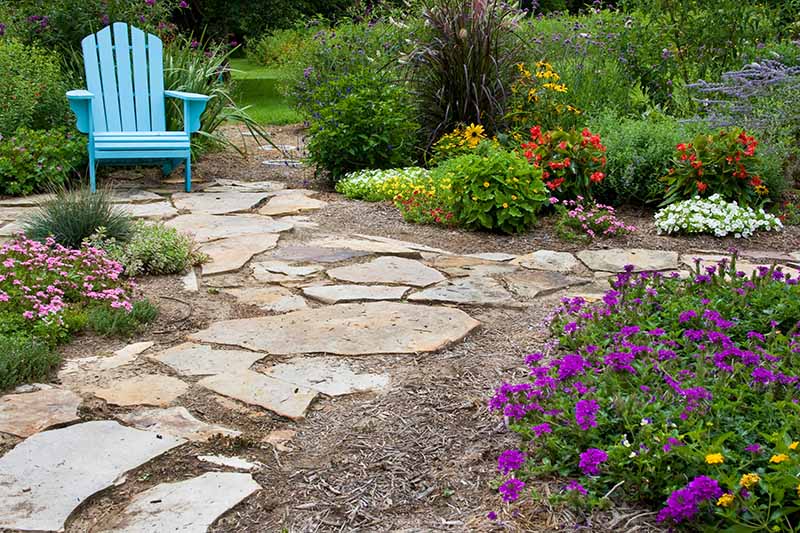
We like to use this colorful sprawler in hot and dry southern regions as ground cover, for filling in around taller plants, or spilling over the edges of retaining walls and embankments.
Quick Reference Growing Guide
| Plant Type: | Flowering perennial | Flower/Foliage Color: | Blue, lavender, pink, purple, red/green |
| Native to: | North and South America, Asia | Water Needs: | Low to moderate |
| Hardiness (USDA Zone): | 8-11 | Soil Type: | Average |
| Season: | Spring, summer, fall | Soil pH: | 5.8-7.2 |
| Exposure: | Full sun | Soil Drainage: | Well-draining |
| Spacing: | 12 feet | Maintenance: | Low to moderate |
| Planting Depth: | 1/4 inch (seeds), depth of root ball (transplants) | Attracts: | Bees, butterflies, hummingbirds, and other pollinators |
| Height: | Up to 3 feet, depending on variety | Uses: | Borders, retaining walls, ground cover, butterfly gardens |
| Spread: | Up to 3 feet, depending on variety | Family: | Verbenaceae |
| Tolerance: | Drought, poor soil | Genus: | Verbena |
| Common Pests and Diseases: | Aphids, leaf miners, spider mites, thrips, whiteflies; powdery mildew | Species: | Bonariensis, bracteata, canadensis, gooddingii, peruviana, and hybrids |
Tough and Durable, or Namby-Pamby?
Just kidding. All varieties of verbena are lovely, but as with all plants, it’s important to choose the type that does well in the region where you’ll be planting it.
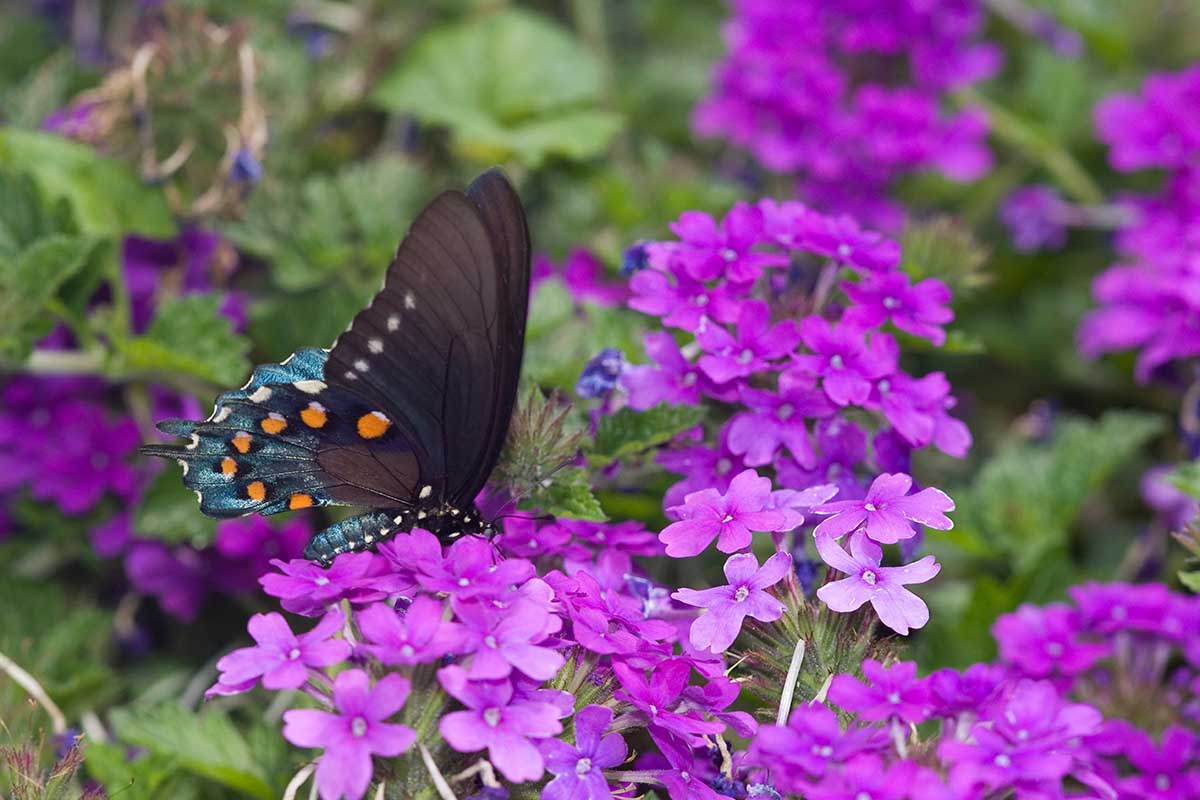
Just as nature intended, plants have evolved in various areas to withstand their native conditions. It makes sense to use the plants that are native to our area in our gardens.
Verbenas built for the south or southwest will withstand the heat, drought, and whatever else Mother Nature chooses to hurl their way – so take your time, and select the right variety for your area.
Do you already have this lovely bit of greenery in your garden? Share where you live and which variety does well there in the comments below! And feel free to send pictures too.
And for more information about growing drought tolerant plants, check out these guides next:
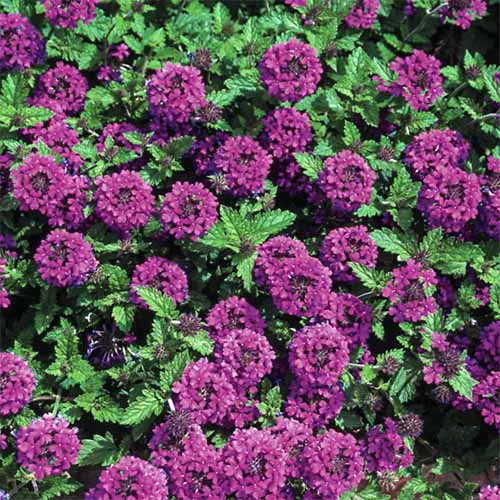
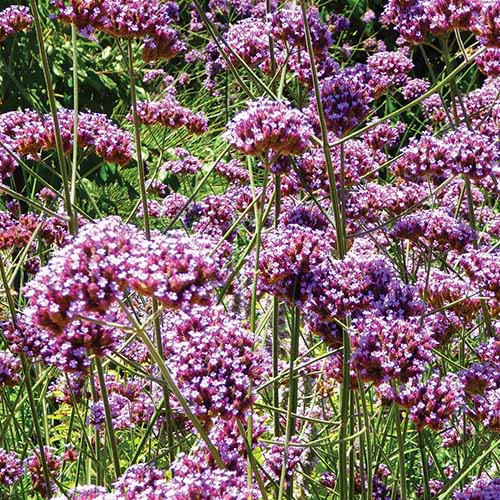
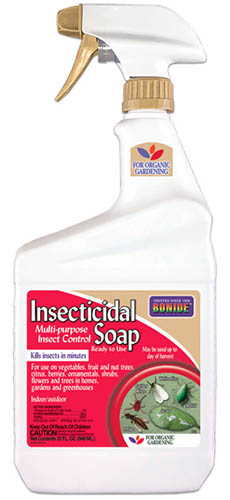
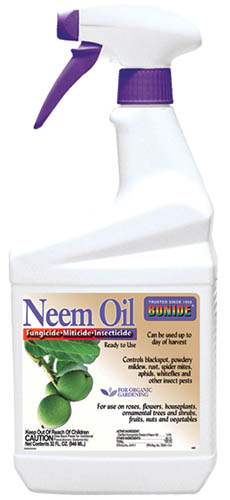
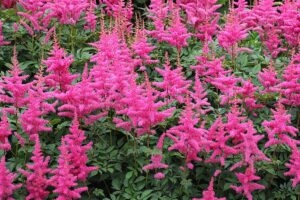
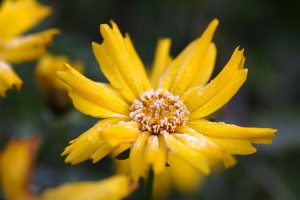
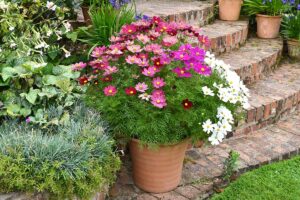
I planted my verbena in the spring from plants we got at at nursery. They were doing so well but began to look like they needed water as summer began. We installed a sprinkler system that waters them every other day for about 15 minutes. Now the plants on one side of our garden have turned brown and very dry. What is wrong with them and can I save them. I live in Houston where it has been in the high 90’s and 100 degrees for several weeks.
Hello, Susan. I am sorry to hear about these overly dry verbenas. I have a few ideas about what’s causing the issue. First, I’m wondering if they are planted in well-draining soil. That’s important to verbena and helps the roots take up water and nutrition they need to stay alive–without getting waterlogged. Second, those scorching temperatures are probably a bit too much for the plants if they’re not yet well-established. Once they’re growing well and blooming, they are drought- and heat-tolerant, but in the first few months after transplanting they need consistent moisture. Third, and probably most important, these flowers… Read more »
I live in Northern CA in the Sacramento valley. It usually is over 100 degrees in the summer here. I planted Verbena Tapien as a ground cover in full sun last year. The plants were BEAUTIFUL. I didn’t trim them back since they rooted as they grew. This year in the spring, beautiful again… and then they all turned brown. Still flowering but nowhere near last year since they flower only on new growth. Because I have 20 of these I couldn’t possibly trim them by hand, it would have taken weeks. (thank you for the tip about using a… Read more »
Hello, Polly. I’m so glad you’ve grown beautiful verbena in the past.It’s a joy,isn’t it? I do wonder if there’s any chance the last planting with those centered drip lines ended up getting root rot. Or is there a chance the soil didn’t drain well enough after any supplemental watering the plants received? It’s probably worth giving Superbena a try. They’re known to be extra drought resistant, which sounds like it could be an asset in the Sacramento Valley. And they’d only need pruning or pinching if you wanted them to have a fuller shape. It’s probably a good time… Read more »